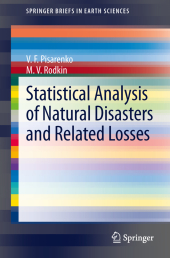 Neuerscheinungen 2013Stand: 2020-01-07 |
Schnellsuche
ISBN/Stichwort/Autor
|
Herderstraße 10
10625 Berlin
Tel.: 030 315 714 16
Fax 030 315 714 14
info@buchspektrum.de |

V. F. Pisarenko, M. V. Rodkin
(Beteiligte)
Statistical Analysis of Natural Disasters and Related Losses
2014. 2013. xi, 81 S. 84 SW-Abb., 5 Tabellen. 235 mm
Verlag/Jahr: SPRINGER, BERLIN; SPRINGER INTERNATIONAL PUBLISHING 2013
ISBN: 3-319-01453-6 (3319014536)
Neue ISBN: 978-3-319-01453-1 (9783319014531)
Preis und Lieferzeit: Bitte klicken
The study of disaster statistics and disaster occurrence is a complicated interdisciplinary field involving the interplay of new theoretical findings from several scientific fields like mathematics, physics, and computer science. Statistical studies on the mode of occurrence of natural disasters largely rely on fundamental findings in the statistics of rare events, which were derived in the 20th century. With regard to natural disasters, it is not so much the fact that the importance of this problem for mankind was recognized during the last third of the 20th century - the myths one encounters in ancient civilizations show that the problem of disasters has always been recognized - rather, it is the fact that mankind now possesses the necessary theoretical and practical tools to effectively study natural disasters, which in turn supports effective, major practical measures to minimize their impact. All the above factors have resulted in considerable progress in natural disaster research.
Substantial accrued material on natural disasters and the use of advanced recording techniques have opened new doors for empirical analysis. However, despite the considerable progress made, the situation is still far from ideal. Sufficiently complete catalogs of events are still not available for many types of disasters, and the methodological and even terminological bases of research need to be further developed and standardized.
The present monograph summarizes recent advances in the field of disaster statistics, primarily focusing on the occurrence of disasters that can be described by distributions with heavy tails. These disasters typically occur on a very broad range of scales, the rare greatest events being capable of causing losses comparable to the total losses of all smaller disasters of the same type.
Audience:
This SpringerBrief will be a valuable resource for those working in the fields of natural disaster research, risk assessment and loss mitigation at regional and federal governing bodies and in the insurance business, as well as for a broad range of readers interested in problems concerning natural disasters and their effects on human life.
The statistical methods of disaster analysis.- The heavy-tail distributions and their properties.- The contribution of maximum effect to the total, summarized effect under different distributions.- The stable approach to the risk assessment: estimation of quantiles of maximum effect.- Non-stationary natural processes, the "operational time" method.- The comparative study of disaster statistics for various natural disasters.- Earthquakes (energy, ground acceleration).- Floods, hurricanes (victims, overall economic losses, insured losses).- Tornadoes (victims, overall economic losses, insured losses).


